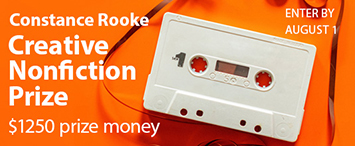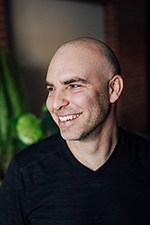|
|
Two weeks left to submit!

Have a story to tell? Creative nonfiction is a genre that embraces, but is not limited to, the personal essay, memoir, narrative nonfiction, social commentary, travel writing, historical accounts, and biography, all enhanced by such elements as description, dramatic scenes, dialogue, and characterization.
This year's judge is Daniel Allen Cox.
Entry fee (includes a 1-year print sub):
$35 CAD for each entry from Canada
$45 CAD for each entry from elsewhere
$15 CAD for each additional entry, no limit
Full contest guidelines on our website.
Daniel Allen Cox, CNF Prize judge
 Editorial and Social Media Assistant Juls Macdonell talks with the CNF Prize judge about his new memoir, how leaving indoctrination behind is a lifelong process, and what he’s looking for in a winning essay. Editorial and Social Media Assistant Juls Macdonell talks with the CNF Prize judge about his new memoir, how leaving indoctrination behind is a lifelong process, and what he’s looking for in a winning essay.
JM: What do you hope to see from contest submissions for the Constance Rooke CNF Prize? How will a winning piece come together for you?
DAC:
Nonfiction in The Malahat Review has always moved me: hybrid and polyvocal, embracing the imperfect, reaching for what lies just beyond, stretching the definition of an essay. I’m looking for essays that take an unexpected slant and are no less beautiful for doing so, in whatever hybrid form the writer needs to tell the story. I will not be policing what “creative nonfiction” means.
I want to be transported both by big ideas and the language at the sentence level, in a piece where the author’s voice is inseparable from the text. I like seeing evidence of thinking on the page—the writer working on a question they don’t readily have the answer to. But an essay doesn’t have to reinvent the world for me to fall in love with it. It can be incredibly moving simply for describing one or two mundane things in a fresh way.
Read the rest of Daniel Allen Cox's interview.
Domenica Martinello, Long Poem Prize winner
 Volunteer Jolene Loveday talks with one of the two 2023 Long Poem Prize winners about the shifting delineations of “good” and “bad,” populating poems with the sumptuous trash of life, and her upcoming book that shares a title with her winning poem, "Good Want." Volunteer Jolene Loveday talks with one of the two 2023 Long Poem Prize winners about the shifting delineations of “good” and “bad,” populating poems with the sumptuous trash of life, and her upcoming book that shares a title with her winning poem, "Good Want."
JL: I adore the many humorous, irreverent lines in “Good Want,” such as “What I want is generic. // A good, cheap stretch. / Nylon, spandex, whatever / the hell jeggings are made from.” What techniques do you employ to balance moments of levity and solemnity in the long poem form?
DM:
Thank you! People finding me or my writing funny is my favourite compliment. Dealing with solemn or vulnerable subject matter can feel tight and uncomfortable, so my impulse is usually skewed towards humour to deflate some of the air in the balloon. For me, achieving the right balance consists of ensuring that I’m not using irreverence as an avoidance tactic. I’ve come to realize that sometimes my desire to be funny in a poem is actually a sign I need to sit with discomfort for longer.
As for techniques, being unhurried affords me critical distance. I write slowly, tinker slowly, then put poems away for months at a time before coming back to revise them. By this point, they feel cool to the touch and can be handled with less preciousness. It’s usually at this point where I can see if humour is working for, or against, what I’m trying to do.
I like the lines you mentioned because I like populating poems, even the most solemn, with the sumptuous trash of life. Jeggings deserve their place on the poetic record!
Read the rest of Domenica Martinello's interview.
Bren Simmers, Long Poem Prize winner
 Volunteer Karla Hirsch talks with one of the two 2023 Long Poem Prize winners about wrestling with ongoing revisions, writing during an uncertain period of life, and the challenge of talking about poem-making in her winning poem, “Cloud Études.” Volunteer Karla Hirsch talks with one of the two 2023 Long Poem Prize winners about wrestling with ongoing revisions, writing during an uncertain period of life, and the challenge of talking about poem-making in her winning poem, “Cloud Études.”
KH: Your poem works with different structures—the long, prose-like footnotes with the broken-up stanzas. There’s a movement here that mirrors the movement of clouds across a sky. I’d love to hear about the structure of the poem and your process of finding it.
BS:
It took five years and many iterations to find the right structure. “Cloud Études” began as a series of prose entries that I later revised. During the pandemic, I decided to deconstruct my habitual ways of writing by using these entries as a source text for cut-up poems. I physically cut each prose entry into individual words and placed them in an envelope. I then applied an arbitrary formula based on percentage of cloud cover to pick a certain number of words and rearrange them into cloud shapes.
Months of Tetris on the kitchen table ensued. I took pictures, picked the best iterations, then paired them with the source text. I reordered and deleted pairings as I wrestled with ongoing revisions. Once I had an overall arc that worked, I massaged the structure to present the two elements in conversation. I started with facing pages, the source material on the left and poem on right. Then poem on the left and prose on the right, but ultimately found the material too repetitive. Next, I tried deleting the source material, though the clouds lacked context when presented on their own. Finally, I experimented with footnotes which allowed the clouds to be the visual focus. At a late stage, I wrote “How to Write a Cloud” as a way for the reader to enter the poem.
Read the rest of Bren Simmers' interview.
|
|
|
|
|
|
|
|
|
|
|
|